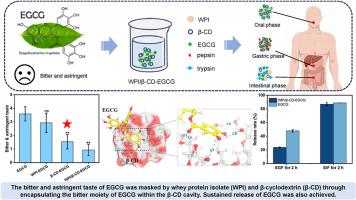Encapsulation of EGCG by whey protein isolate and β-cyclodextrin nanocomplexes: A strategy to mask the bitter and astringent taste and increase the stability in beverages
IF 11
1区 农林科学
Q1 CHEMISTRY, APPLIED
引用次数: 0
Abstract
(−)-Epigallocatechin-3-gallate (EGCG) is the main active component of tea polyphenols, which endows tea with bitter and astringent taste and is susceptible to degradation in presence of light, heat and oxygen. In this study, whey protein isolate (WPI) and β-cyclodextrin (β-CD) were used to prepare the WPI-β-CD nanocomplexes for masking the bitter taste and protecting EGCG. The encapsulation efficiency of EGCG by WPI-β-CD nanocomplexes reached to 79.61%. Sensory evaluation indicated that the bitter and astringent taste of EGCG was masked. FTIR results suggested that the WPI/β-CD-EGCG nanocomplexes were formed through electrostatic, hydrogen bonding and hydrophobic interactions among WPI, β-CD and EGCG. The molecular mechanism of taste masking was preliminarily investigated by molecular docking, suggesting that the bitter and astringent taste moiety of EGCG was inserted into the hydrophobic cavity of β-CD, thereby masking the bitter and astringent taste of EGCG. The results of in vitro gastrointestinal experiments and scanning electron microscopy indicated that the WPI-β-CD nanocomplexes effectively encapsulated EGCG and achieved sustained release in simulated gastrointestinal conditions, thus showing potential application prospects in tea beverages and related areas.

用分离乳清蛋白和β-环糊精纳米复合物包封EGCG:掩盖苦涩味并提高饮料稳定性的策略
(-)-表没食子儿茶素-3-棓酸盐(EGCG)是茶多酚的主要活性成分,它赋予茶叶苦涩的味道,在光、热和氧气的作用下容易降解。本研究采用乳清蛋白分离物(WPI)和β-环糊精(β-CD)制备了 WPI-β-CD 纳米复合物,用于掩盖苦涩味和保护 EGCG。WPI-β-CD 纳米复合物对 EGCG 的包封效率达到 79.61%。感官评价表明,EGCG 的苦涩味被掩盖了。傅立叶变换红外光谱结果表明,WPI/β-CD-EGCG 纳米复合物是通过 WPI、β-CD 和 EGCG 之间的静电、氢键和疏水相互作用形成的。通过分子对接初步研究了掩味的分子机理,认为EGCG的苦涩味分子插入了β-CD的疏水空腔,从而掩盖了EGCG的苦涩味。体外胃肠道实验和扫描电镜结果表明,WPI-β-CD 纳米复合物能有效包覆 EGCG,并在模拟胃肠道条件下实现持续释放,因此在茶饮料及相关领域具有潜在的应用前景。
本文章由计算机程序翻译,如有差异,请以英文原文为准。
求助全文
约1分钟内获得全文
求助全文
来源期刊

Food Hydrocolloids
工程技术-食品科技
CiteScore
19.90
自引率
14.00%
发文量
871
审稿时长
37 days
期刊介绍:
Food Hydrocolloids publishes original and innovative research focused on the characterization, functional properties, and applications of hydrocolloid materials used in food products. These hydrocolloids, defined as polysaccharides and proteins of commercial importance, are added to control aspects such as texture, stability, rheology, and sensory properties. The research's primary emphasis should be on the hydrocolloids themselves, with thorough descriptions of their source, nature, and physicochemical characteristics. Manuscripts are expected to clearly outline specific aims and objectives, include a fundamental discussion of research findings at the molecular level, and address the significance of the results. Studies on hydrocolloids in complex formulations should concentrate on their overall properties and mechanisms of action, while simple formulation development studies may not be considered for publication.
The main areas of interest are:
-Chemical and physicochemical characterisation
Thermal properties including glass transitions and conformational changes-
Rheological properties including viscosity, viscoelastic properties and gelation behaviour-
The influence on organoleptic properties-
Interfacial properties including stabilisation of dispersions, emulsions and foams-
Film forming properties with application to edible films and active packaging-
Encapsulation and controlled release of active compounds-
The influence on health including their role as dietary fibre-
Manipulation of hydrocolloid structure and functionality through chemical, biochemical and physical processes-
New hydrocolloids and hydrocolloid sources of commercial potential.
The Journal also publishes Review articles that provide an overview of the latest developments in topics of specific interest to researchers in this field of activity.
 求助内容:
求助内容: 应助结果提醒方式:
应助结果提醒方式:


